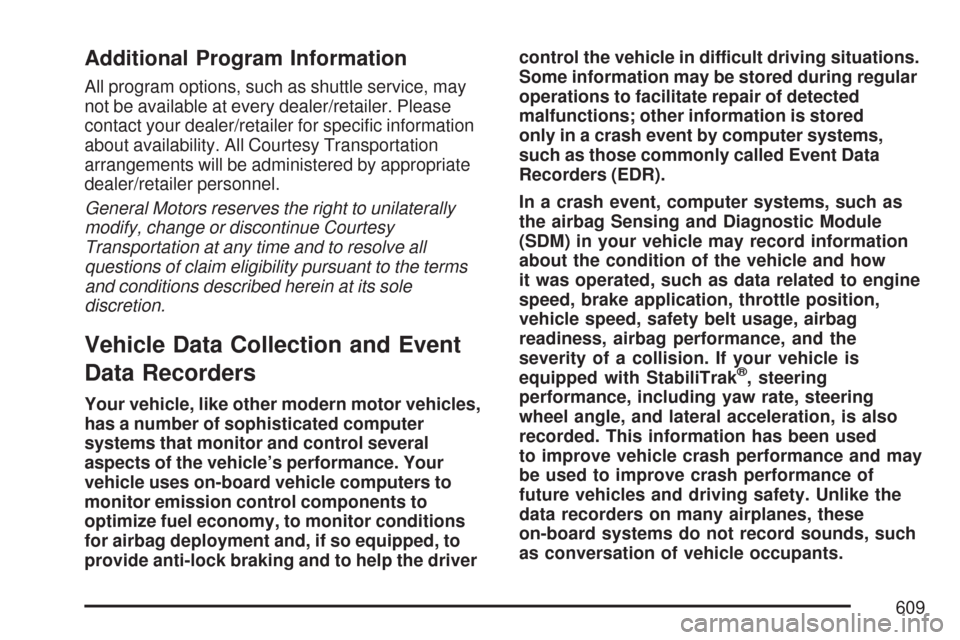Page 404 of 634

Run your engine only as long as you must. This
saves fuel. When you run the engine, make it go a
little faster than just idle. That is, push the
accelerator slightly. This uses less fuel for the
heat that you get and it keeps the battery charged.
You will need a well-charged battery to restart
the vehicle, and possibly for signaling later on with
your headlamps. Let the heater run for a while.
Then, shut the engine off and close the window
almost all the way to preserve the heat. Start
the engine again and repeat this only when you
feel really uncomfortable from the cold. But do it as
little as possible. Preserve the fuel as long as
you can. To help keep warm, you can get out of
the vehicle and do some fairly vigorous exercises
every half hour or so until help comes.If Your Vehicle is Stuck in Sand,
Mud, Ice, or Snow
In order to free your vehicle when it is stuck, you
need to spin the wheels, but you do not want
to spin the wheels too fast. The method known as
rocking can help you get out when you are
stuck, but you must use caution.
{CAUTION:
If you let your vehicle’s tires spin at high
speed, they can explode, and you or
others could be injured. And, the
transmission or other parts of the vehicle
can overheat. That could cause an engine
compartment �re or other damage. When
you are stuck, spin the wheels as little as
possible. Do not spin the wheels above
35 mph (55 km/h) as shown on the
speedometer.
404
Page 414 of 634
The snow plow manufacturer or installer can
assist you in determining the amount of rear
ballast required, to help make sure your
snowplow/vehicle combination does not exceed
the GVW rating, the front and rear axle ratings,
and the front and rear weight distribution ratio.
The total vehicle must not exceed the GVW
rating.
Q:What is front axle reserve capacity, and
how do I calculate it?
A:Front axle reserve capacity is the difference
between your front Gross Axle Weight Rating
(GAWR) and the front axle weight of your
vehicle with full fuel and passengers. Basically,
it is the amount of weight you can add to
your front axle before reaching your
front GAWR.The front axle reserve capacity for your vehicle
can be found in the lower right corner of the
Certi�cation/Tire label, as shown.
United StatesCanada
414
Page 417 of 634

Q:What is total vehicle reserve capacity?
A:This is the difference between your GVWR and
the weight of your vehicle with full fuel and
passengers. It is the amount of weight you can
add to your vehicle before reaching your
GVWR. Keep in mind that reserve capacity
numbers are intended as a guide when
selecting the amount of equipment or cargo
your vehicle can carry. If you are unsure
of your vehicle’s front, rear, or total weight, go
to a weigh station and weigh your vehicle.
Your dealer can also help you with this.
The total vehicle reserve capacity for your
vehicle can be found in the lower right corner
of the Certi�cation/Tire label as shown
previously.
See your dealer for additional advice and
information about using a snow plow on your
vehicle. Also, seeLoading Your Vehicle on
page 407.
Emergency Roof Lamp Provisions
Vehicles with the RPO VYU snow plow prep
package also have an emergency roof lamp
provision package, RPO TRW. Wiring for the
emergency roof lamp is provided above the
overhead console. SeeAuxiliary Roof Mounted
Lamp on page 218for switch location.
Towing
Towing Your Vehicle
Consult your dealer or a professional towing
service if you need to have your disabled vehicle
towed. SeeRoadside Assistance Program on
page 604.
If you want to tow your vehicle behind another
vehicle for recreational purposes (such as behind
a motorhome), see “Recreational Vehicle
Towing” following.
417
Page 609 of 634

Additional Program Information
All program options, such as shuttle service, may
not be available at every dealer/retailer. Please
contact your dealer/retailer for speci�c information
about availability. All Courtesy Transportation
arrangements will be administered by appropriate
dealer/retailer personnel.
General Motors reserves the right to unilaterally
modify, change or discontinue Courtesy
Transportation at any time and to resolve all
questions of claim eligibility pursuant to the terms
and conditions described herein at its sole
discretion.
Vehicle Data Collection and Event
Data Recorders
Your vehicle, like other modern motor vehicles,
has a number of sophisticated computer
systems that monitor and control several
aspects of the vehicle’s performance. Your
vehicle uses on-board vehicle computers to
monitor emission control components to
optimize fuel economy, to monitor conditions
for airbag deployment and, if so equipped, to
provide anti-lock braking and to help the drivercontrol the vehicle in difficult driving situations.
Some information may be stored during regular
operations to facilitate repair of detected
malfunctions; other information is stored
only in a crash event by computer systems,
such as those commonly called Event Data
Recorders (EDR).
In a crash event, computer systems, such as
the airbag Sensing and Diagnostic Module
(SDM) in your vehicle may record information
about the condition of the vehicle and how
it was operated, such as data related to engine
speed, brake application, throttle position,
vehicle speed, safety belt usage, airbag
readiness, airbag performance, and the
severity of a collision. If your vehicle is
equipped with StabiliTrak
®, steering
performance, including yaw rate, steering
wheel angle, and lateral acceleration, is also
recorded. This information has been used
to improve vehicle crash performance and may
be used to improve crash performance of
future vehicles and driving safety. Unlike the
data recorders on many airplanes, these
on-board systems do not record sounds, such
as conversation of vehicle occupants.
609